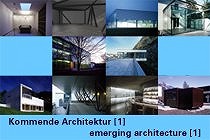
|
Emerging Architecture 1 - Kommende Architektur 1 10 offices Location: Architekturzentrum Wien - Old hall Exhibition: 21 September 2000 - 30 October 2000 Opening Hours: daily 10:00 A.M to 7:00 P.M. Opening: Wednesday 20 September 2000, 7pm Riepl Riepl Hofgasse 9 A-4020 Linz A U S T R I A Phone +43 (732) 78 23 00 Fax +43 (732) 78 23 00 - 19 arch@rieplriepl.com www.rieplriepl.com Peter Riepl Born in 1952 in Upper Austria, studied Architecture at the TU Innsbruck. Since 1985, joint office with Gabriele Riepl in Linz. 1988 - 1994 partnership with Thomas Moser. 2000 Guest professor at the GhK Kassel. Gabriele Riepl Born in 1954 in Tirol. 1973 - 1979 studied Architecture at the TU Vienna and the University of Innsbruck. 1989 Cultural prize of the province Upper Austria. 1990 and 1998, Builder’s prize of the Central Organization of Architects, Austria. Buildings, Projects (selection): * 1986 - 1989 conversion of Hagenberg Castle, Upper Austria * 1995 - 1998 O.K. Center for Modern Art in Linz * 1996 - 1997 Engel factory Steyr * 1995 - 1998 Management Academy Bergschlössl, Linz * 1998 Secondary schools in Wels, Wallererstrasse and Linz, Ramsauerstrasse * 1997 - 1999, Cultural Center Bruckmühle, Pregarten, Upper Austria * 1999, Office building, Linz Riepl Riepl transpose ambivalence on the re-enactment of a place, and they avoid linear causal chains and uninspired materialism. Peter Riepl speaks of "wobbly effect" as a strategy to leave the classical purism behind. The existing, free-standing building for the Open Cultural Center Linz emerges almost unseathed; the activation of the previously "blind" back court and the color scheme enhance the corporality of the old building, yet, in certain moods of light, the graphite wash (by Bitter/ Weber) creates a sense of immateriality. Placing a glass pavilion on the roof, however, manifests the old building as solid foundation, which is comparable to the rocks, on which the Parthenon is built. For the castle Bergschlössl in Linz, a puristic, glazed structure is inserted as a low-volume background and filter between the baroque edifice and the park. A glass wing is added as a quiet background and filter between the baroque building and the park. The new building becomes, seen from different angles, a vehement kaleidoscope mirroring villa and sky (on the south side), transparency to the park (in the middle) and semi-transparency through lighting (north side). At the music school in Pregarten, the main undifferentiated body of the hall appears on the exterior, to be built as an echo of the nearby granite rocks, proves to be, however, an exact expression of the acoustics and sight lines of the interior. So can the act of building bring a presence to place that befits a contemporary world where, as Lucius Burckhardt says: "Nothing is what it appears to be; only appearances are not deceptive". [...] |
 |
|
|
|
Current Preview Permanent Exhibition Emerging Architecture 1 - Kommende Architektur 1 Press Release The 10 offices * Bulant & Wailzer * Peter Ebner * Geiswinkler & Geiswinkler * Kaufmann 96 GmbH * Rainer Köberl * lichtblau . wagner * Marte.Marte * Pichler & Traupmann * Riepl Riepl * Splitterwerk Gallery: Emerging Architecture 1 - Kommende Architektur 1 E-Shop Products: Book: Emerging Architecture 1 / Kommende Architektur 1 DVD: Emerging Architecture 1 - Kommende Architektur 1 Information: Ines Purtauf Tel.: +43 (1) 522 31 15 - 25 Fax: +43 (1) 522 31 17 Email: purtauf@azw.at |
| © Architekturzentrum Wien 2025 |
||



